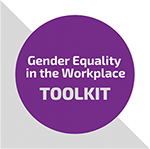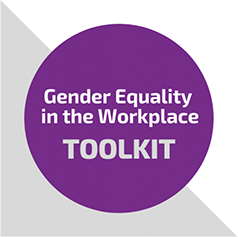Stage 2
Beginning the Change Journey
What does a workplace at this stage look like?
A workplace at this stage is open to discussions about gender equity and the prevention of violence against women as a priority issue that aligns with the core business of the organisation. The workplace is committed to exploring how their workplace can be more gender responsive and understands their role in preventing violence against women.
At this stage, a workplace has an interest in developing internal systems or reviewing and developing policies that positively affect gender equity or the prevention of violence against women.
The leadership team will also have a genuine interest in expressing their commitment in their business plans, to realise their workplace's potential to be more gender responsive.
Staff within this workplace will have become more aware of gender equity and the prevention of violence against women through their workplace’s participation in key campaigns, and are interested in their workplace becoming more gender responsive.
What does a workplace at this stage want?
This stage is about reflecting on current workplace practices, and setting the stage for action.
A workplace at this stage is ready to analyse how their current systems, structures and culture affect gender equity and the prevention of violence against women. The workplace is interested in establishing a solid foundation of knowledge that will enable a gender equality and/or prevention of violence against women strategy and gender equality action plan to be developed.
A workplace will be interested in exploring training with leadership to ensure they understand violence against women and the role of the workplace in prevention.
A workplace at this stage is ready to put forward a business case for workplace gender equality.
A workplace at this stage is also ready to build the capacity of their staff to confidently identify and respond to disclosures of family violence and understand the drivers of that violence.
What Opportunities are available for a workplace at this stage?
There are a number of tools a workplace can adopt to analyse their current structures, policies and culture:

Workplace Gender Audit
A gender audit refers to an assessment of the extent to which an organisation is gender equitable in order to inform gender equity action. The audit is useful for benchmarking an organisation and providing a foundation for further action.
Gender audits analyse the three essential elements of a gender transformative workplace; leadership, strategy, and norms and practices. This process involves the examination and assessment of a range of areas that include governance, policies, programs, plans, workplace structures, employment processes and structures, services, budgets, and facilities.
A gender audit is an important tool to collect the data needed to support the development of workplace-gender equity strategies. It can also assist in the measure and evaluation of the success of these initiatives.
The Quick Audit Tool and Checklist for Gender Responsive Organisations can be utilised by employees or managers to self-assess the current environment of the workplace. The results can then be used to support a business case for a whole-of-organisation gender audit.
Once a workplace has secured genuine commitment through leadership, WHISE or an external agency or consultant, can support you to tailor an audit package to reflect your specific workplace needs.
WHISE, in conjunction with Women’s Information and Referral Exchange (WIRE) have created a guide on how to choose a family violence and gender equity training and consultancy that will deliver results for your organisation.
Quick Audit Tool
This condensed Quick Audit Tool can be completed in 10 -15 minutes and will give an individual or team within a workplace a clear idea of how many of the core gender equity and prevention of violence against women initiatives their workplace is currently practicing.
For any queries in relation to this tool, please contact WHISE
Checklist for Gender Responsive Organisations
To get a more detailed understanding of how your organisation is tracking in core components of gender equity and the prevention of family violence, you can complete this in-depth internal checklist, ideally with other members of your team.
The Checklist for Gender Responsive Organisations is self-guided, and reflective of the OurWatch Workplace Equality Respect (WER) Standards, which represent our national best practice for gender equity and the prevention of violence against women in the workplace.
Completing a more in depth analysis will provide a solid basis to build a business case for your workplace to conduct a full gender equity audit, and to identify their next steps on the PVAW journey.
Developing a Business Case
The first step to conducting a Workplace Gender Audit is building a business case to gain the support of senior leadership. Commitment from the senior leadership team is critical to the evolution of workplace attitudes, behaviour and structures.
Identifying an approach that aligns with the specific needs of your organisation will strengthen your case for an audit. Tailoring your case to your organisation highlights the importance and relevance, specific to your workplace.
WHISE has created a quick guide to developing a business case and we can also coach workplaces through the creation of the business case.
Gender Equality Action Plans
To achieve gender equality in your workplace, organisations need to:
- understand why they need gender equality
- identify where they need to change
- plan and prioritise actions that will achieve progress
- secure resources and track progress over time
That is why the Gender Equality Act 2020 requires organisation to develop a Gender Equality Action Plan (GEAP) every 4 years.
Your GEAP will help you plan, implement and measure change. To understand what you need to do and see if your organisation is obligated to report on gender equality progress go to the Public Sector Gender Equality Commissioner
Gender Equity and Prevention of Violence against Women training
As your workplace begins its change journey, the staff and leadership team will benefit from capacity building training to raise their awareness and knowledge of gender equity and violence against women, and to begin to consider how these concepts can be address in the workplace.
The training can be tailored to your specific workplace needs and can range from anything from a 2 hour workshop to a series of whole day trainings. There are a number of training opportunities for workplaces who wish to build the capacity of their workforce, WHISE provides training in gender equity, and in the prevention of violence against women on request, as do our peak bodies, including OurWatch and Respect Victoria, VicHealth and Family Life.
WHISE, in conjunction with Women’s Information and Referral Exchange (WIRE) have created a guide on how to choose a family violence and gender equity training and consultancy package or provider that will deliver results for your organisation.
Become a partner to the Women’s Health in the South East Regional Strategy
As a regional women’s health service, WHISE’s core business is in gender equity, the prevention of violence against women, and women’s sexual and reproductive health.
This involves the coordination of a regional strategy for the prevention of violence against women, to unite our regional partners in common gender equity and prevention of violence against women goals.
The Preventing Violence Together regional strategy for the Southern Metropolitan Region is the key engagement point for all women and family services in the Southern Metropolitan Region.
By becoming a partner to the Regional Strategy, your workplace can contribute more broadly to community change, be linked in with evolving best practice, be connected with a network of peers and access free training and professional development.
Please contact us for more information on how to become a partner.
Leadership Commitment to Gender Equality and Prevention of Violence against Women
As the leadership team drive the culture, systems and policies of the workplace, providing opportunities for genuine commitment to principles of gender equity and the prevention of violence against women will support sustainable change within an organisation.
In a perfect world, genuine commitment from the leadership team means an equal representation of men and women in leadership roles, leadership rejecting any form of violence or harassment, strong modelling of respectful relationships and strong communication of the workplaces’ commitment to gender equity.
However at this early stage, success can look like an internal or public commitment from the leadership team to a particular goal i.e. the completion of a gender equity audit, or training for all staff in gender equity.
Key Tools to assist
workplaces
Checkpoint:
Stage 2
What needs to occur before you move onto the next stage?
Our workplace has completed the following:
1. We have engaged with staff to raise awareness of gender equity and the prevention of violence against women
How have we done this?
We have provided staff with training on gender equity and the prevention of violence against women; and
We have made referral pathways clear to staff, and referral services are displayed openly in our workplace.
2. We have assessed our workplace systems, policies and culture
How have we done this?
We have completed the Quick Audit or the Checklist for Gender Responsive Organisations to assess how gender responsive our internal systems, policies and culture are; and
We have engaged with an external agency in a full GE audit or evaluation of our policies, based on the areas of concern revealed in our internal audit.
3. We have ensured that our staff and leadership team are ready to begin planning how our workplace can be more gender responsive
How have we done this?
We have surveyed our workforce, on their views about genuine commitment to principles of gender equity and prevention of violence against women, and we had a positive result; and
We have become a partner to the regional strategy; and
Our leadership team have made a commitment to specific gender equity and prevention of violence against women initiatives.
Our Watch; Workplace Equality Respect Standards have heavily informed our check points, for practical advice on the tools to adopt to measure these milestones, please access the WER standards.

